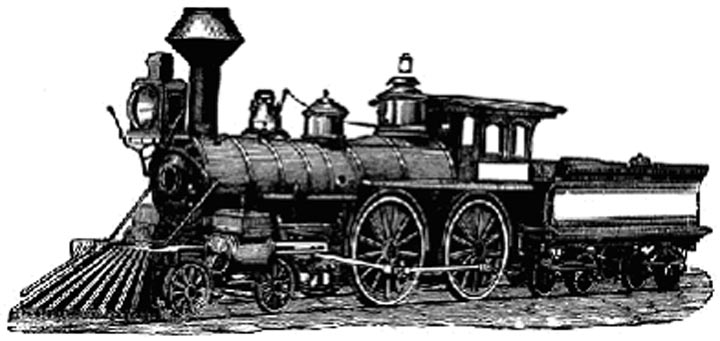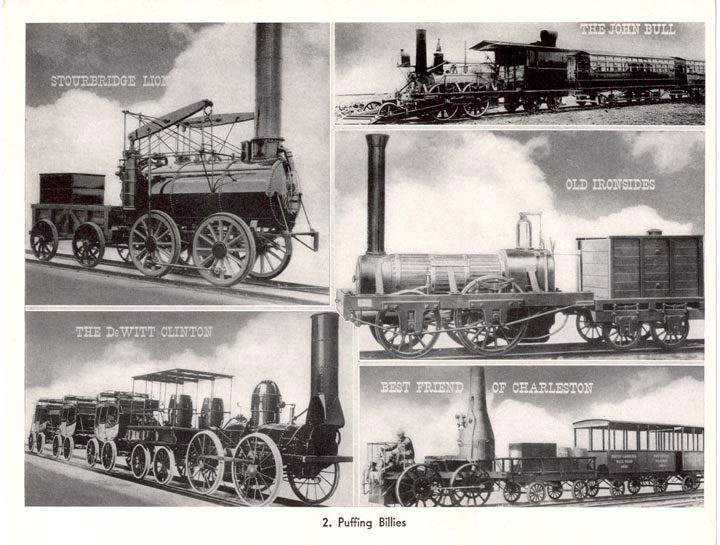Association of American Railroads Teacher’s Kit – Part II
Presented by Bill Fuller
In the early 1940s, the Association of American Railroads (AAR) offered a Teacher’s Kit for use in teaching public school students about the transportation industry. Of course, in the mind of the AAR, transportation equaled railroads, and the kit includes over 50 photographs of railroad scenes. Each photograph is accompanied by a descriptive story, each of which becomes a short history lesson in the place of railroading in American culture and economy. A complete copy of the original kit is in the archives of the High Plains Western Heritage Center, Spearfish, South Dakota. Its contents have been scanned and reprinted for public viewing in the Heritage Center by TCA member Bill Fuller, who has also provided a copy to e*Train. Each new issue will feature one of the photographs and its story. This issue features story and photograph 1, presented in the second part of this article titled “Story 1”.
“By way of explanation, What are you looking at?
This binder contains the photographs and copies of the descriptive text from a Teacher’s Kit furnished by the Association of American Railroads. The complete kit contained the 56 photographs now in this binder and two booklets:
A Study of Railway Transportation • Volume 1, Teacher’s Manual for Primary and Intermediate Grades with Bibliography
and
A Study of Railway Transportation • Volume 2, The Stories Behind the Pictures for Primary and Intermediate Grades.
Also in the shipping envelope is a colored booklet advertising the textbook series Study Arithmetics, 1943 Revision, published by Scott, Foresman and Company.
Judging by the latest dates of statistics and tables presented in the Volume 2 booklet, printed dates on the title pages of both booklets, and the publishing company advertisement, it is probable that the information in the kit was collected in 1941, printed in 1942, and distributed in 1943. The original booklets, the publishing company advertisement, and the original mailing envelope are in the archives of the High Plains Western Heritage Center, 825 Heritage Drive, Spearfish, SD 57783, Acquisition Number 340.
The “East and West Railroad” or “E & W” shown in the photographs never existed. Actual railroad names were replaced in the photographs probably to avoid the appearance of giving free advertising to some railroad lines while slighting others.
What is the Association of American Railroads?
The 1941 – 1943 Teacher’s Kit containing these photographs and descriptive text was published by the Association of American Railroads (AAR). The following information about this organization is quoted from the AAR Web sites http://www.aar.org/About_AAR/aar_history.asp and http://www.aar.org/About_AAR/about_aar.asp, retrieved November 23, 2004:
The AAR was formed in 1934. But its history really goes back much further–all the way to 1867 when the Master Car Builders Association was formed to conduct experiments aimed at standardizing freight cars.
Soon other organizations representing other railroad subjects were formed. By the early 1930s, there was an alphabet soup of organizations representing the industry. Included were the Association of Railway Executives, the American Railway Association, the Bureau of Railway Economics, the Railway Treasury Officers Association, the Railway Accounting Officers Association and the Bureau for the Safe Transportation of Explosives and other Dangerous Articles. These and others were folded into the new Association of American Railroads, when it was established on October 12, 1934.
The unification of rail associations was a fallout from the Great Depression. In 1933 the Rail Transportation Act was passed and a Federal Coordinator of Transportation was appointed to deal with depression-era problems affecting railroads. Beset by a plethora of voices representing the railroad industry, Coordinator Joseph B. Eastman – with the support of President Franklin D. Roosevelt – soon recommended that railroads unify into one organization that could speak for the entire industry, leading directly to creation of the AAR.
AAR members include the major freight railroads in the United States, Canada and Mexico, as well as Amtrak. Based in Washington, DC, the AAR is committed to keeping the railroads of North America safe, fast, efficient, clean, and technologically advanced. Much of the AAR focus is on Washington, bringing critical rail-related issues to the attention of Congressional and government leaders.
The AAR is also very much involved in programs to improve the efficiency, safety and service of the railroad industry. Two AAR subsidiaries – the Transportation Technology Center, Inc., and Railinc – ensure that railroads remain on the cutting edge of transportation and information technology.
Railroads are the vital link to our economic future. More than 40 percent of all US freight moves by rail – more than from any other single mode of transportation. As Fortune Magazine recently observed, “While Internet companies scramble for sound business footing, many of America’s trains are running on Internet time – at a profit.”
© 2004 AAR 50 F Street, NW, Washington, DC 20001-1564 •• 202-639-2100
Used with permission”
Story # 2
The first locomotives aroused a great deal of interest. People traveled many miles just to see them. What made them go was a mystery to many persons. People called them “Iron Horses,” “Puffing Billies,” and “Steam Wagons.”
Among the famous locomotives of pioneer days, in addition to the “Tom Thumb,” were the “Stourbridge Lion,” the “Best Friend of Charleston,” the “DeWitt Clinton,” the “John Bull,” and “Old Ironsides.”
The “Stourbridge Lion” was the first full-sized locomotive to be operated on a railroad in America. It was built in England and shipped across the Atlantic in a sailing vessel. Its first trip under its own power was made on the line between Honesdale and Carbondale, in Pennsylvania, in August, 1829. Young Horatio Allen, who purchased the engine in England, was the engineer. Because of the dangers involved, no one was allowed to ride with Allen. Although the “Lion” weighed only seven tons, it was found to be too heavy for the bridges and tracks, so the railroad operators returned to the use of horses or mules for motive power.
The “Best Friend of Charleston” was the first locomotive to be placed in regular daily service in America. This historic locomotive was built at the West Point Foundry, in New York City, and shipped by sailing vessel to Charleston, South Carolina, in October, 1830. It made its trial trip with a trainload of passengers over a few miles of complete railroad out of Charleston on November 2, 1830, and was placed in regular scheduled service on Christmas Day of that year. The engine continued in service for several months. Then one day the fireman fastened down the safety value in an effort to stop the hissing noise caused by escaping steam. The boiler blew up, seriously injuring the fireman and ending the career of the “Best Friend.”
The “DeWitt Clinton” was the first locomotive to haul passengers in New York State. This engine also was built at the West Point Foundry. It made its first trip from Albany to Schenectady in August, 1831. On that historic occasion the locomotive drew a train of carriages with a distinguished passenger list. The “DeWitt Clinton” was named for Governor DeWitt Clinton, of New York, who signed the railroad charter and was a great friend of canals and railroads.
The “John Bull” was the first locomotive to pull a train of cars in New Jersey and the first locomotive in the world to be equipped with a “cow catcher.” It was named “John Bull” because it was built in England. The engine made its first run over a railroad at Bordentown, N.J., on November 12, 1831, and it ran on that road for many years. In 1893, after years of idleness, the engine, pulling two pioneer coaches, made a 920-mile trip under its own power to Chicago, where it was a World’s Fair attraction. The historic locomotive is now one of the permanent exhibits of the Smithsonian Institution in Washington.
“Old Ironsides,” the pioneer locomotive of Philadelphia, began running regularly on a railroad between Philadelphia and Norristown on November 23, 1832. Matthias W. Baldwin was a jeweler and watchmaker. When business fell off, he turned to the manufacture of tools and textile machines. A steam engine was needed to run his factory. Instead of buying one, Mr. Baldwin decided to build it himself. The engine was so successful that he decided to try his hand at locomotives. “Old Ironsides” was the result, and thus began Mr. Baldwin’s notable career as a locomotive builder.
When these locomotives were built and placed in service, transportation in America was slow and difficult indeed. Travel and transportation by land was largely by horseback, stagecoach, ox carts and Conestoga wagons. There were few roads of any kind, and most of them were crude and ill-kept.
Railway transportation represented a great improvement over the modes of transportation then in common use.







